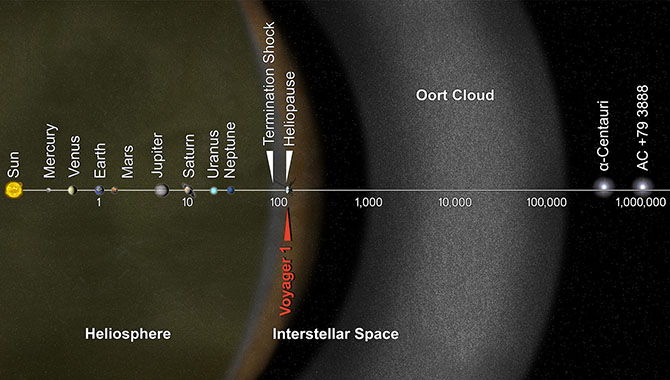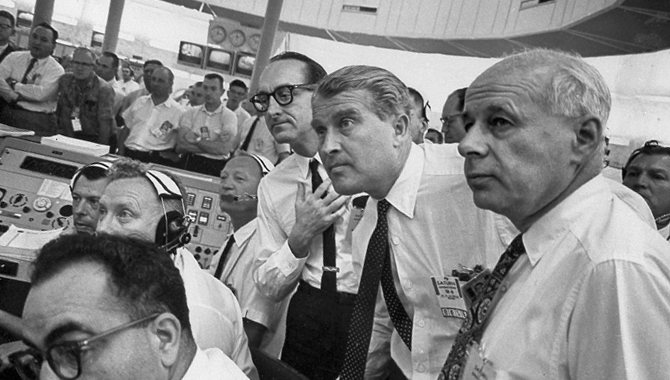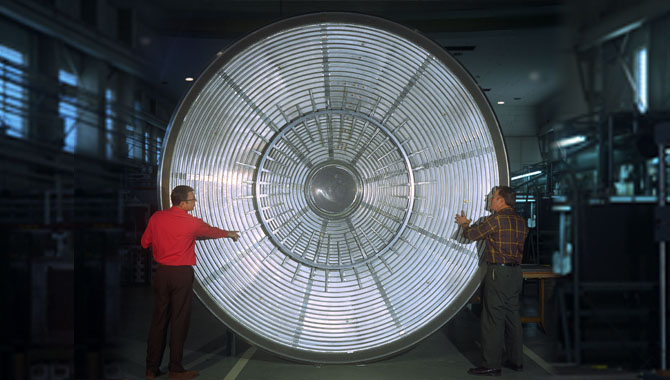
This artist’s concept pinpoints the location of Voyager 1 as it crossed into interstellar space in August 2012.
Image Credit: NASA/JPL-Caltech
Forty years ago, Voyagers 1 and 2 blasted off to explore the outer planets. Thirty-five years later, Voyager 1 became the first spacecraft ever to enter interstellar space.
The Voyager program was designed as a two-spacecraft mission to take advantage of a rare planetary alignment that would allow NASA to explore the outer solar system planets. The idea emerged in the 1960s, when NASA scientists uncovered a unique phenomenon: once every 176 years, all of the planets in the solar system are grouped to one side of the sun. The scientists realized that a spacecraft launched in 1977 could take advantage of this rare event to fly by all four outer planets in far less time than would otherwise be necessary. Using a gravity assist technique to swing from planet to planet, a voyage to Neptune could take 12 years instead of 30.

The launch of Voyager 2 on August 20, 1977, from Cape Canaveral, Florida. Voyager 1 followed just over two weeks later on September 5.
Photo Credit: NASA/JPL-Caltech
Voyager 2 was the first to launch: it rocketed away from Cape Canaveral on August 20, 1977, followed weeks later by Voyager 1 on September 5. Over the next 12 years, the twin spacecraft explored the outer planets. Voyager 1 visited Jupiter and Saturn, while Voyager 2 flew past all four gas giants. At that point, they began heading in different directions through interplanetary space—Voyager 1 going north, Voyager 2 aiming south—as they traveled farther and farther from the sun.
Originally designed to last five years, no one expected the twin spacecraft to continue to deliver groundbreaking scientific data 40 years after launch, but that’s exactly what they have done. Their durability is attributed, in part, to the fact that they were built to withstand the radiation emanating from Jupiter. Over the years, non-essential functions were shut down to preserve energy so the spacecraft could continue a new phase of their work: the Voyager Interstellar Mission (VIM). The objective of VIM is to travel as far from the sun as possible, moving beyond the sun’s magnetic field into interstellar space to gather data on interstellar fields, particles, and waves.
To achieve their objective, the Voyager spacecraft are on trajectories out of the heliosphere: the wind sock-shaped region governed by the sun’s magnetic field, which is filled with particles that flow from the sun as solar wind. In the first phase of the VIM, the spacecraft crossed the termination shock: the point where the expansion of the solar wind is curbed by the pressure of the opposing interstellar wind. Here, the speed of the solar wind diminishes from supersonic to subsonic, and the flow of particles begins to shift direction. The second phase of the VIM is the heliosheath, the final region of the heliosphere, where the solar wind mixes with interstellar gases. Eventually, both spacecraft will journey past the heliopause, roughly eight to fourteen billion miles away from the sun, to enter interstellar space.
In December 2004, Voyager 1 crossed the termination shock. Voyager 2, moving more slowly than its twin, did the same in August 2007 and is now traveling through the heliosheath. Voyager 1 has gone farther: scientists determined that on August 25, 2012—almost exactly 35 years after launch—it became the first spacecraft ever to cross the heliopause into interstellar space.
Both spacecraft continue to return new observations every day. Starting in 2020, as their electrical power runs out, their instruments will be turned off one by one until the final components are shut down by 2030. But that doesn’t mean their voyages will end: each will travel onward forever, continuing to go where no spacecraft has gone before.
The Voyager spacecraft were built and are operated by the Jet Propulsion Laboratory. The missions are part of NASA’s Heliophysics System Observatory, sponsored by the Heliophysics Division of the Science Mission Directorate.
Watch and listen to this video as Voyager 1 experiences three “tsunami waves” in interstellar space.









